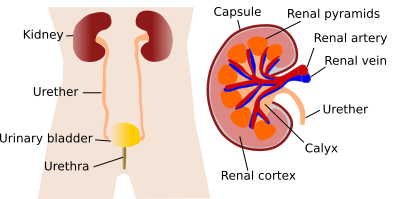Every living thing produces waste in its body and has a way to get rid of it. The excretory system manages waste production and elimination in humans. The excretory process is aided by the capillary networks and specific structures that make up this system. The nephron, the functional component of the kidneys, is part of the human excretory system. Specialized hormones that control the rate of nephron absorption control the excretory activity of the kidneys.
Excretory Organs
The human excretory system organs include:
- A pair of kidneys
- A pair of ureters
- A urinary bladder
- A urethra
1. Kidneys
Kidneys are bean-shaped organs that are situated on either side of the backbone and are shielded from external damage by the ribs and back muscles. Each adult human kidney measures 10–12 cm in length, 5-7 cm in breadth, and weighs about 120–170 g. The interior of the kidneys is concave. The hilum, a notch in the inner concave surface of the kidney, is where the ureter, blood vessels, and nerves enter the kidneys. The renal pelvis, a sizable funnel-shaped area found inside the hilum, is made up of many projections called calyces.
Structure of Kidney
Capsule; The capsule is the name of the outermost layer. There are two zones within the kidney: the cortex is in the outer zone and the medulla is in the inner zone. The cortex extends in between the medullary pyramids as renal columns called columns of Bertin.
Nephron; The functioning component of a kidney is called a nephron. In fact, there are millions of nephrons in each kidney. They all are working together to filter blood and remove wastes. It is made up of the following components:
- Bowman’s capsule; The Bowman’s capsule is the nephron’s initial segment. It is a structure in the form of a cup that receives blood vessels. Here, glomerular filtration takes place. The blood still contains the proteins and blood cells.
- Proximal Convoluted Tubule; The proximal tubule is formed by the Bowman’s capsule extending downward. Water and reusable materials from the blood are now reabsorbed back into it.
- The loop of Henle; The formation of a u-shaped loop known as the Loop of Henle is facilitated by the proximal tubule. The u-shaped bend, the ascending limb, and the descending limb are its three constituent parts. Due to the resorption of water, urine concentrates in this region. Water can pass through the descending limb but cannot via the ascending limb.
- Distal Convoluted Tubule; The Loop of Henle connects to this structure. It is the location of the kidney hormones’ action.
- Collecting Ducts; The collecting ducts are connected to the distal convoluted tubule of each nephron. Together, the collecting ducts make up the renal pelvis. Urine travels from the renal pelvis through the ureter and bladder.
click here to study more about the structure of the kidney.
2. Ureters
Each kidney has a single ureter that emerges from the renal pelvis. It is a thin, muscular tube that transports urine from the kidneys to the bladder.
3. Urinary Bladder
The bladder resembles a sac. Additionally, a layer of smooth muscle lines it. It holds the pee till micturition. The act of passing urine from the body is known as micturition. The ureters, one from each kidney, deliver urine to the bladder. Men and women have a different level of bladder location in the body.
4. Urethra
The urine bladder gives rise to a tube called the urethra. Its purpose is to release the urine outside by micturition. It is longer in men and shorter in women. Additionally, it serves as a common pathway for urine and sperm in males. The sphincter also protects the urethra’s entrance.
Other Excretory Organs
There are other organs that perform excretion in addition to the ones mentioned above. They are as follows:
Skin
The largest organ in the body is the skin. Its main purpose is to safeguard the body’s many organs. Sweat is a waste product of the skin. In particular, the skin gets rid of substances like NaCl, some urea, etc.
Liver
The liver plays a crucial role in the body’s elimination of waste. When it comes to hormones, lipids, alcohol, and narcotics, it is the first line of defense. In fact, this organ is where the majority of medicines are first-pass metabolized. A few medications are also eliminated through the kidneys. The liver also gets rid of extra fat and cholesterol. This is essential to maintain the health of the body.
Lungs
The main respiratory organs are the lungs. They aid in absorbing oxygen and releasing carbon dioxide. However, they also remove some water in the form of vapour during this process.
Functions of the Excretory System
The excretory system serves a variety of purposes, including:
- Using urine to eliminate waste materials including urea, uric acid, ammonia, and other chemical compounds.
- Maintaining the blood’s and plasma’s osmotic balance
- Maintaining the body’s electrolyte balance
- Additionally, it aids in the metabolism of medications that are not metabolized by the liver.
